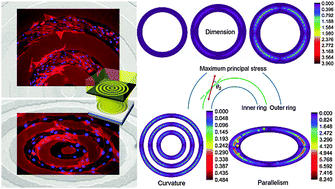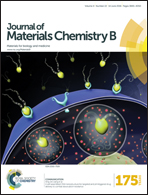Direct cellular organization with ring-shaped composite polymers and glass substrates for urethral sphincter tissue engineering†
Abstract
Although fundamental efforts have been made to engineer circular smooth muscle layers in vitro, engineering structured skeletal muscle tissue equivalents acting as sphincters remains to be investigated. Groove patterned substrates made of homogeneous materials usually lead to cell monolayers instead of patterned cell sheets while patterned matrices failed to generate circular myotubes because cell chirality blocks the end-to-end cellular sequence corresponding to pattern directions. In this paper, we proposed concentric circular and elliptical microgroove patterned substrates with glass substrates as grooves and polymers as ridges to direct ring-shaped myoblast patterns and maximize cell alignment with respect to constraint directions, which are essential for circular myotube generation towards sphincter tissue engineering. Our results showed that our substrates direct myoblasts to proliferate in and orient along the directions of glass grooves, leading to a higher cell alignment degree than homogeneous substrates can achieve. We also found that the cell alignment degree depends on dimensions and parallelism rather than the curvature of the constraint. On the basis of these findings, we proposed finite element models that quantitatively account for our experimental data and emphasized the role of intercellular forces in cell alignment modulation. These results suggest that narrow curved constraints with parallel boundaries can favourably maximize myoblast alignment and facilitate myogenic differentiation regardless of constraint curvature, which will underpin the design of substrates and scaffolds for urethral sphincter or other hollow tissue engineering applications.


 Please wait while we load your content...
Please wait while we load your content...